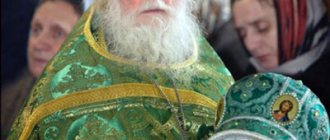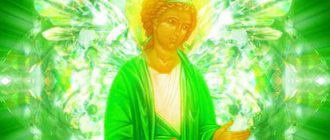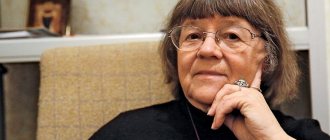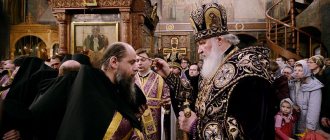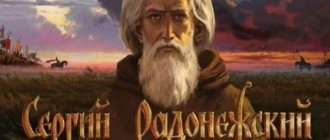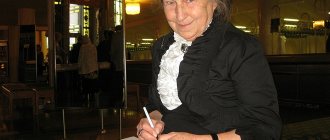| Archim. Rafail (Karelin) |
Rafail (Karelin)
(born 1931), Archimandrite In the world Ruslan Nikolaevich Karelin, was born on December 28, 1931 in Tbilisi in the family of Nikolai Aleksandrovich Karelin and Alexandra Nikolaevna Churkina, an engineer and teacher. He did not receive a religious upbringing in the family, his parents were indifferent towards religion - his father was an agnostic; the mother is a believer, but did not show it. A family lived on the outskirts of Kirovabad (now Ganja), where the father worked as an engineer at a diesel power plant. The boy got used to being alone early and fell in love with reading.
When he was 6 or 7 years old, his grandmother took him to church several times, and this experience had a deep impact on the child. As he later wrote:
«
There was no external effect that could excite the imagination of a child, but there was something else: as if the bow of an invisible musician touched the deepest strings of the heart, and these strings, previously silent, now sounded in response... I remember that I left the temple different than I went into it. But this feeling did not last long, it disappeared, as if it did not exist: the world, like the wind, blew out the candle lit in the child’s soul
.»
Another time a spiritual shock occurred to him in childhood, when he opened and read the Gospel a little. However, at the time the boy hid this experience, convinced that no one would understand him [1].
His conscious spiritual quest began in the last grades of school. One of the milestones on this path was the book of St. John Chrysostom “Commentary on Genesis.” At one time he thought to find God in books. But then, one day entering the Kvashveti Marininsky Church in Tbilisi, he experienced what he later called “ internal evidence, invisible evidence.”
“that “
the truth is here
” [1].
After graduating from school, he entered the philological faculty of TPI. At this time, his spiritual turning point occurred - turning to God. Having found his way into monasticism, at the age of 23, he took monastic vows in 1954. At the same time, he accepted the priesthood in the clergy of the Georgian Orthodox Church.
From 1958 to 1973, he served in the Sukhumi-Abkhaz diocese, where the main events of his inner spiritual life took place, which he wrote about in his memoirs in the book “On the Path from Time to Eternity.” He became the spiritual child of the Glinsky elder St. Seraphim (Romantsov), and had close communication with the Rev. Metropolitan Zinovy (Mazhuga). I received a blessing from my spiritual mentors to write books [1].
Due to catarrhal throat disease, he could not continue his priestly service in the temple and returned to Tbilisi for treatment.
From 1975 to 1995 he taught Slavic language, asceticism, basic theology and history of religions at the Tbilisi Theological Seminary, and then at the Theological Academy.
Since 1995, due to an eye disease, he was forced to leave ministry, both at the academy and in the temple. Since 1990, he began literary activity, which he continues to this day.
He became one of the most prolific and famous Russian-language church writers about asceticism, about many pressing problems of Christian life of his time. In particular, he acted as one of the principled and consistent critics of the theology of Professor A.I. Osipov [2]. A number of his works were translated into Georgian, Bulgarian, Serbian, Romanian and other languages. In addition to a large number of books and many articles, he also published answers to questions from his spiritual children and questioners, and maintained his own website.
Monasticism
Having secretly accepted monasticism in 1954 under the name of Archangel Raphael, he was soon ordained to the rank of hierodeacon, and then hieromonk.
Due to the lack of religious institutions in Georgia, the young priest goes to the monastery of St. Olga for training, there he is immersed in the study of church sacraments, services, prayers and all other subtleties that a priest needs to know.
His first place of service was the village of Ilori, in which the St. George Church was located. It was here that Father Raphael first encountered the manifestation of demonic forces, freeing those possessed by evil spirits from them through prayer and fasting.
Biography of Archimandrite Raphael
In the last years of school I became interested in metaphysical questions. At that time, religious literature was very difficult to obtain. I accidentally came across a book of the works of St. John Chrysostom, which struck me with its novelty and depth of thought, as well as its brilliant style. This book largely determined my future spiritual path. I did not receive any religious or anti-religious upbringing in my family.
My father was an atheist. He said that he lost his faith in his youth, but he never spoke offensively about religion, which was then in fashion. He was generally distinguished by great tolerance and respected the beliefs of other people. His spiritual inner world still remains a mystery to me.
My mother was a believer, but at that time she did not show her religiosity - she was, as it were, a believer “for herself” and believed that the children, when they grew up, would figure out these issues themselves.
I remember two religious experiences of my childhood that were particularly etched in my soul and memory. My grandmother Evdokia took me – then a 5 or 6 year old child – to the temple. Of course, I didn’t understand anything about what was happening there, but in my soul I felt contact with some invisible force, with the secret that the temple keeps within itself. I didn’t understand what was going on around me, but I felt that something extraordinary was happening in my own soul and that something was changing in it, that I was coming into contact with an unknown new world. For some time I was under the impression of this event, but gradually it weakened and disappeared from my memory. I remembered and seemed to relive it many years later.
My second religious experience in childhood was reading the Gospel, or rather excerpts from the Gospel. I caught a cold and lay in bed for several days. And, behold, on the windowsill, near my head, I saw a book - it was the Gospel belonging to my grandmother. I opened it and started reading. And again I was overcome by the feeling of the presence of an invisible spiritual world. It seemed to me that some kind of light stream was emanating from this book, and as if someone had transported me to those places and times when Christ preached.
Now I am convinced that the Gospel should be given to children to read. Although they cannot understand it on a rational level, they are nevertheless capable of experiencing it internally, mystically, and perhaps their experiences are deeper and more immediate than later, when with age the soul is covered with sins and passions, like a layer of dust. After graduating from school, I entered college. During this period, I developed a desire to devote my life to God - to become a monk. At that time there was not a single functioning monastery in Georgia; monastic tonsures were performed secretly. Most of the monks were physically destroyed after the revolution; some monks managed, through the Committee for the Protection of Monuments, to become guards at closed monasteries and even conduct services. Some of the nuns took up positions as singers at existing churches, but they dressed in lay clothes so as not to attract attention to themselves.
I also wanted to receive secret tonsure, but God’s providence judged differently. I was unexpectedly summoned by the rector of the Alexander Nevsky Church, Archimandrite Zinovy Mazhuga (later Metropolitan of Tetritskaro). He said that one parish does not have a priest and therefore services have not been held there for a long time. He invited me to be ordained. This coincided with my desire to become a monk and I agreed. On the recommendation and guarantee of Metropolitan Zinovy, Patriarch Melchizedek III ordained me as a hierodeacon, and then as a hieromonk. At that time there was no theological seminary in Georgia, and for training in practical worship I was sent to Mtskheta to the Olga Monastery, where I was taught by Abbess Angelina (Kudimova), who herself was a teacher for many years. I remember this old lady with deep gratitude.
The Path of the Servant
In 1958, Archimandrite Karelin was transferred to the suburbs of Sukhumi as a priest to the cemetery Church of the Transfiguration of the Lord, where over 15 years of service he passed the main path of his spiritual formation, described by the author in the book “On the Path from Time to Eternity.”
Rafail Karelin is a cleric of the Georgian Orthodox Church
In the Sukhumi-Abkhaz diocese, the Lord granted the young priest a unique meeting with St. Seraphim, the elder of the Glinsk hermitage, in which he spent 12 years. After the closure of the desert, Archimandrite Seraphim (Romantsov), living in Kyrgyzstan, spends all his time in prayers, reading them while sitting on a stone.
In the person of Father Seraphim, recognized as a saint in 2010, Father Raphael found a true spiritual father, trustee and mentor. The wise old man had a unique gift of love for people, which he hid under feigned severity, but he always tried to show sensitivity to people's problems.
During the Sukhumi period, Metropolitan Zinovy (Mazhuga) of Tetritskaro, a true admirer of the Jesus Prayer, met on the path of the saint; he was canonized in 2010. As a mature man, Father Raphael travels a lot to the holy monasteries of Russia; a visit to the Pskov-Pechersky Monastery especially impresses Karelin.
Mature age
In adulthood, Father Raphael traveled a lot to holy places and monasteries in Russia. More than once he visited the Pskov-Pechersky Monastery, which left the strongest imprint on his soul. Already as an adult, he graduated from the Moscow Theological Seminary. His spiritual mentor was schema-abbot Savva, who became famous for reading prayers over sick people. There are many cases where people recovered after this. It was schema-abbot Savva who prompted Father Raphael to start writing books.
Teaching at the Theological Academy
The year 1975 was marked for Archimandrite Raphael by teaching the Slavic language at the Mtskheta Theological Seminary, as well as asceticism, the history of religions and theology at the Tbilisi Theological Academy.
Service in the temple
The last place where Father Rafail served was the temple of Prince Alexander Nevsky in Tbilisi. Illness and severe loss of vision prevented him from continuing his service.
In 2021, for the first time, a meeting between the Pope and the Patriarch of All Rus' took place, at which a joint declaration was signed. Archimandrite Raphael was among several clergy who spoke extremely negatively about the meeting between the patriarch and the pope. They stated that their joint declaration was a heretical document because all existing church rules were violated because of this meeting.
Literary activity
Being a spiritual publicist, Fr. Raphael published many books criticizing church modernism, which is loyal to various movements of religion. He is completely intolerant of ecumenism in the Church, which allows the unification of all Christian denominations, including Protestants, Catholics, Uniates and others.
Archimandrite Karelin, whose books do not leave anyone indifferent, tries to convey to a wide audience answers about the purpose of the church, the path of the soul and spirit, the meaning of God and the meaning of Christ’s sacrifice. Based on broad erudition, excellent command of literary style, and having spiritual experience, the priest tries to help humanity find the answer to the eternal question about the meaning of life, sin and faith.
His literary work can be divided into areas.
- In his moral and ascetic works, the Monk Raphael delves deeply into the problems of the spiritual world, explaining to the general reader the structure and mutual connections in it. The works of a priest of this direction say a lot about the fact that a person should be content with what he has, be able to limit himself and know moderation in everything.
- The message “The Church and the Intelligentsia” addresses the issue of the relationship between the church and the intelligentsia, because both of these structures are called upon to bring truth, morality and light to the world.
- In the collection of questions and answers “In Search of Truth,” the author examines the topic of the meaning of life, enriching the spiritual life of those who read his works. A worthy and righteous life, according to the priest, is possible only after death to sin. Passions have enslaved the bulk of people who do not understand that a short time on earth is not reserved for pleasure and joy, but for finding the path to eternal life, which gives real happiness.
- In the book “On the Language of the Orthodox Icon,” the author treats with trepidation the holy images painted by holy icon painters, but sharply criticizes paintings on a religious theme by Vrubel and Dali.
- Separately, we should highlight the collections of messages of Archimandrite Raphael, in which the priest arranged answers to questions of concern to parishioners by topic.
Rafail Karelin. Christianity and modernism
Based on an analysis of his own mistakes, he gives advice to people seeking God in the following collections:
- “On the stone of faith. Questions and answers";
- “But no one will deceive you. Questions and answers";
- “The sea of life. Answers to readers' questions";
- “This mystery is great. Questions and answers about family life."
In his collections, the monk raises problematic issues of the church, pseudoculture, and modern modernism in Orthodoxy: “The Mystery of Salvation. Conversations about spiritual life”, “Orthodoxy and the temptations of this world”, “On the eternal and transitory”, “On the way from time to eternity. Memories".
The sermons of Archimandrite Raphael deserve special attention. In an original and unusual form, during services the priest teaches, admonishes and consoles those people who are looking for the truth of life.
In 1999, a collection of sermons, “The Way of a Christian,” was published, describing the inner side of church life. In his revelations, the priest shares advice on how to get closer to the Lord, and what can alienate Christians from Him, how to overcome passions, and what kind of fight to wage against demons.
Disagreements with Osipov
Many begin to look for some differences in the views and teachings on various spiritual topics of such theologians as Archimandrite Raphael and A.I. Osipov. On some forums, whole discussions took place over which of them was right. But there is no need to delve deeply into this, because each of these spiritual writers will be right in their own way. And there is nothing reprehensible in this if someone openly expresses their opinion.
Archimandrite Rafail Karelin spoke out about Osipov, in particular, because of the article “The Eucharist and the Priesthood.” He didn't like some of the statements there. But if you provide a field for dispute between these two titans of theological literature, then they will never argue with each other, since they also do not have complete knowledge about the spiritual world, and therefore they too may be mistaken in something.

